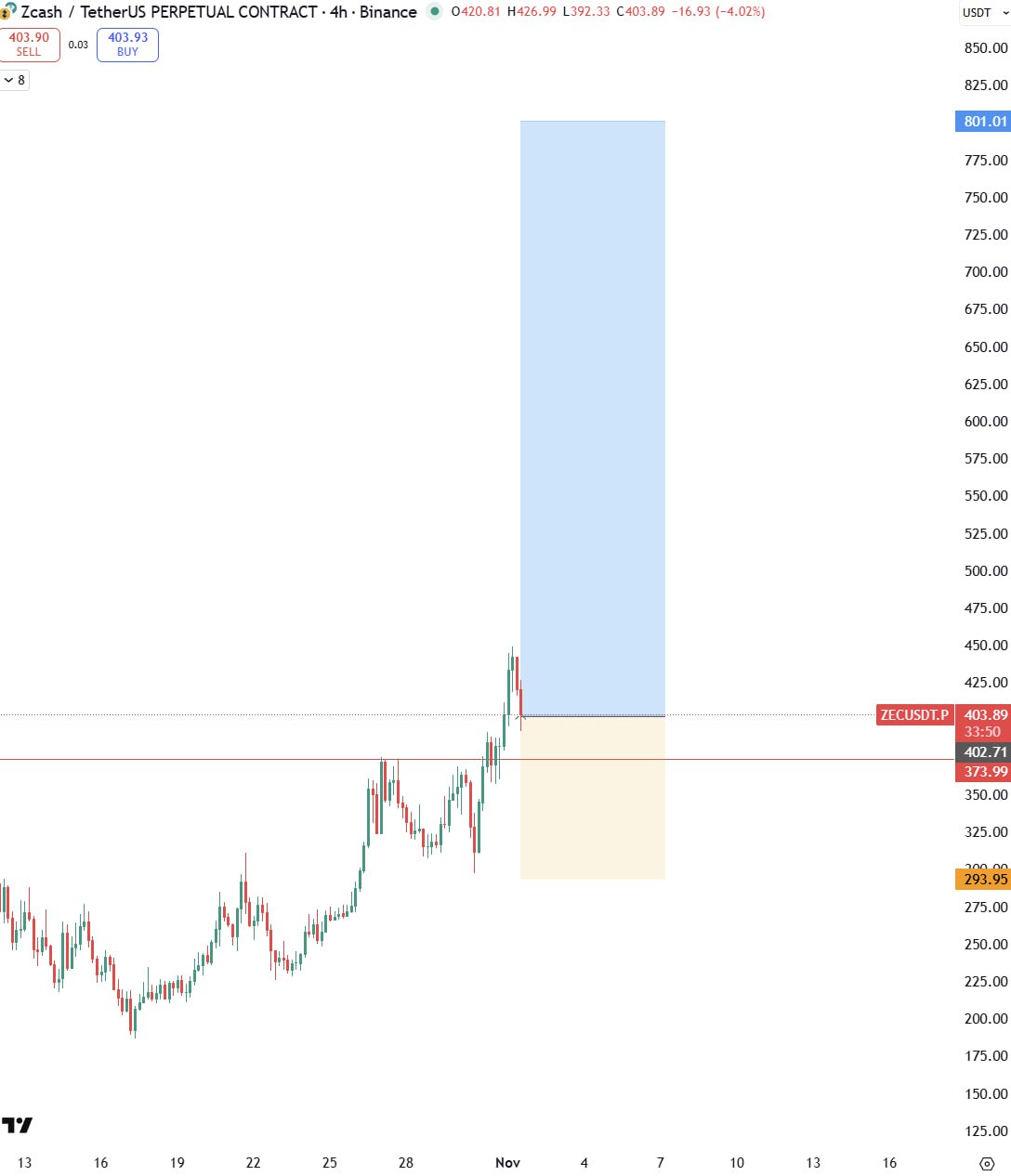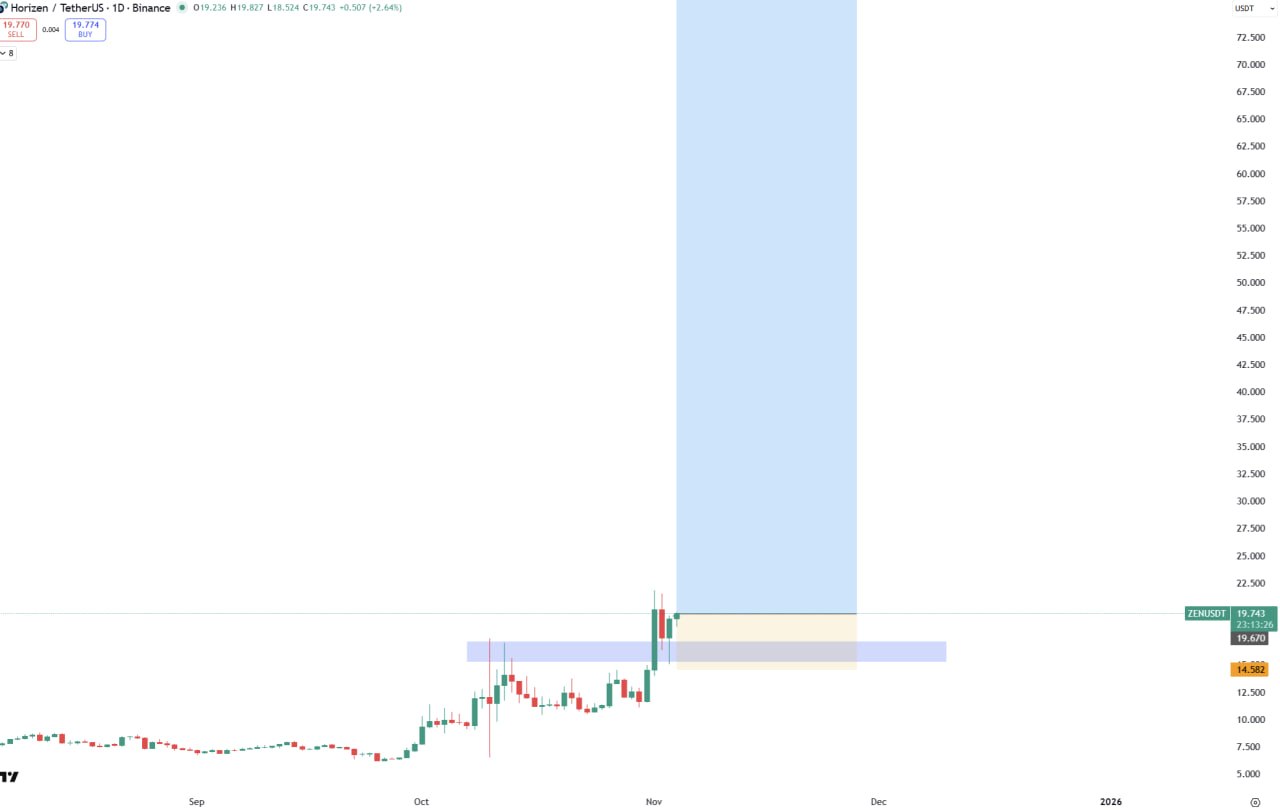ZEC/USDT.P — Long
2025-10-31 10:08
Long ZEC at 406.84 targeting 435 | 462 | 506 with invalidation at 352.85.

If the TradingView symbol is unavailable, use the annotated image as reference for target zones & invalidation.
ZEC/USDT.P Long Trade Signal — October 31, 2025
This blueprint proposes a long in Zcash (ZEC) around 406.84, with profit targets at 435, 462, and 506, and a hard stop at 352.85. ZEC’s character has shifted materially in recent sessions: what was once a sleepy, liquidity-starved instrument has awakened, featuring expanding ranges, elevated turnover, and stronger spot participation. Our plan embraces that change while respecting the risk of volatility reversions that often follow. The aim is to monetize the structural improvement, not to marry a narrative.
Market Context
Regime transitions in crypto rarely occur in isolation. As flows rotate among categories (smart contract platforms, modular stacks, privacy, AI), tokens at the center of a hot theme can exhibit attention convexity: incremental news drives disproportionate price response. In that environment, timing trumps thesis. ZEC has recently benefitted from renewed interest in privacy primitives. Whether that interest persists is unknowable; what’s observable is structure: higher highs, defended pullbacks, and bids that don’t disappear on the first sign of pressure.
Another dynamic: dealers and basis traders. When realized volatility rises, options desks and perp basis strategies become more active, absorbing flows and sometimes amplifying directional moves via hedging. Their participation tends to tighten spreads during liquid hours, reducing the randomness of wicks. Our plan leans on executing during those windows, not in illiquid off-hours where slippage dominates.
Technical Analysis
Market Structure: After a prolonged range, ZEC punched through key supply near the high 300s and accepted above 400. The breakout has been tested but not rejected; pullbacks keep printing higher lows on the 4H. The next resistance stack lies at 435 (prior shelf), then 462 (supply pocket), and 506 (round-number magnet aligning with historical participation).
- Trend: D1 uptrend re-established; 4H shows constructive progression with measured consolidations rather than blowoffs.
- Momentum: Momentum confirms trend, though short, sharp pullbacks are common as leveraged participants rebalance.
- Volume: Breakout volume exceeded the 30-session mean; consolidations see tapering activity—a healthy pattern.
- Liquidity: Depth improved on major venues; still thins quickly during weekends and late sessions.
Key Levels
- Entry: 406.84 (stagger within 404–409 if spreads allow)
- Targets: 435 → 462 → 506
- Stoploss: 352.85 (below the last significant higher low; breach invalidates the swing)
- Support: 398–402 (retest shelf), 382–386 (secondary), 360–364 (deep support)
- Resistance: 435–440, 458–465, 500–510
Execution Tactics
- Enter on a pullback that respects the 398–402 shelf with a 1H close back above 404–405 to confirm absorption.
- Take a risk-first partial at 435; advance your stop to just under the nearest 1H higher low if 435 converts to support.
- Scale another partial at 462. If breadth is strong and funding remains balanced, keep a runner to 506 with a structure-based trailing stop.
- Into 506, either complete the exit or retain a token remainder only if the tape is one-way and order book offers are thinning materially.
Failure Modes
Repeated intraday failures to hold 404 with increasing negative delta, accompanied by rising open interest (fresh shorts), argue for stepping aside before the hard stop. A daily close under 382 would reset the entire setup; do not average down below invalidation—rebuild after structure repairs.
Risk Management
Because ZEC’s volatility has expanded, size positions so that the distance to stop doesn’t exceed your risk budget. Use a hard stop at 352.85. After TP1, your job shifts from risk taker to risk manager—protect paid gains while preserving upside optionality. Avoid the common trap of dragging a stop too tight and getting wicked out before continuation.
- Adopt a maximum daily drawdown (e.g., −2R) and honor it.
- Prefer limit orders near levels; market orders during spikes degrade your average.
- Do not add into resistance; add only on pullbacks that maintain higher-low structure.
- Keep leverage modest; liquidation risk should be far beyond the hard stop.
Educational content, not investment advice. Derivatives and volatile assets can cause losses exceeding expectations. Manage size and respect stops.








